Nanogrid Could Hold Key to Clean Energy Future
The Orlando Utilities Commission’s (OUC’s) vision of a green energy future isn’t as far off as some people may think. The utility’s nanogrid is providing a testing ground for several innovative power systems.
At OUC’s Gardenia Operations Center sits one square acre of outdoor space dedicated to the study of novel clean energy technologies. The nanogrid is a living laboratory of emerging energy assets that could help the utility meet its 2050 goal of net-zero CO2 emissions, with interim emissions reductions of 50% by 2030 and 75% by 2040 from 2005 levels. Managed by OUC’s Emerging Technologies (ET) team, the nanogrid is made up of:
- ■ A floating solar array, which recently was expanded to 64 kW of capacity from 31 kW.
- ■ Three electric vehicle (EV) chargers, including one with vehicle-to-grid (V2G) capability.
- ■ Two vanadium redox flow (VRF) batteries, which are used to store and dispatch energy.
- ■ Two trailers with hydrogen storage tanks—the latest addition to the test site.
Of the diverse components being tested, Sam Choi, manager of Emerging Technologies and Renewables, and Justin Kramer, supervisor of Emerging Technologies, believe hydrogen technology has the potential to revolutionize the energy industry (Figure 1). In 2019, OUC was part of a team that received a $9 million grant from the U.S. Department of Energy (DOE) to study the production, storage, and transport of hydrogen for the dispatching of electricity or as transportation fuel. OUC is one of only a few utilities in the U.S. exploring hydrogen’s potential as a panacea to the challenges of decarbonizing the grid.
 |
|
1. Justin Kramer (left) and Sam Choi (right) stand beside the Orlando Utilities Commission’s (OUC’s) latest addition to its nanogrid—one of two hydrogen storage trailers. Courtesy: OUC |
“Its only byproducts are water vapor, heat, and energy,” said Kramer, explaining the benefits of using hydrogen as a renewable energy source.
At the nanogrid, hydrogen will be produced using a polymer electrolyte membrane (PEM)-based electrolyzer, which is expected to arrive in mid-2021. Connected to a solar array floating on a nearby pond, the electrolyzer performs electrolysis, using electricity to split water into hydrogen and oxygen. The result will be “green hydrogen,” so named because it is produced using renewable energy and, in the process, yields zero carbon emissions. Funneled through a compressor, the hydrogen will be stored in carbon-fiber cylinders stacked in the two trailers.
Paired with fuel cells, which also will arrive in 2021, hydrogen is converted into highly efficient, clean and quiet energy. Choi said one of the two fuel cells his team will test will be situated on a trailer “so we can actually dispatch it with the hydrogen storage tanks and use it as a potential backup power solution, such as for a commercial customer or a pump station hit by an outage.”
The day could come when electrolyzers and fuel cells, and other distributed energy resources like solar and battery storage, are spread across OUC’s service territory as rapid-response systems used to help balance renewable generation and consumption. Choi likened such a scenario to setting up a “virtual power plant.”
“One of the key research concepts of this project is the electrolyzer,” said Choi. “While you’re producing hydrogen, you can ramp up and down that unit to mitigate the fluctuations of solar.” And when the sun isn’t shining, hydrogen offers the best option for backing up solar farms, or any renewable power system for that matter, with long-duration energy storage.
Choi and Kramer believe hydrogen-powered energy technology is on the verge of a breakthrough, and OUC is on the leading edge of it. “The DOE funded only two utilities to do hydrogen research, and we’re one of them,” said Choi.
OUC is funding all other elements of the nanogrid by itself. Data is being collected on the VRF batteries, which offer longer-lasting energy storage capacity than lithium-ion batteries, and a high-speed V2G EV charger that’s capable of pulling power from an EV. The latter experiment is researching the possibility of EVs being used as battery power sources to augment the grid or power homes in times of outages.
Another tool the ET team will study this year is a flywheel energy storage system. It converts mechanical energy into electricity and could be used to store and dispatch power generated by solar. “As we transition to cleaner fuel sources that are less reliable, we need tools to make them more reliable; that’s the whole point of the nanogrid,” said Kramer.
Also under development in collaboration with the University of Central Florida (UCF) are controllers, which Kramer called “the brains behind the operation.” Professors and doctoral students with UCF’s College of Engineering and Computer Science are working with the ET team on this project. “UCF gives us access to so many smart, talented people always willing to help transition Central Florida to cleaner, greener energy,” said Kramer.
—Mike Boslet is senior communications consultant with the Orlando Utilities Commission (OUC).